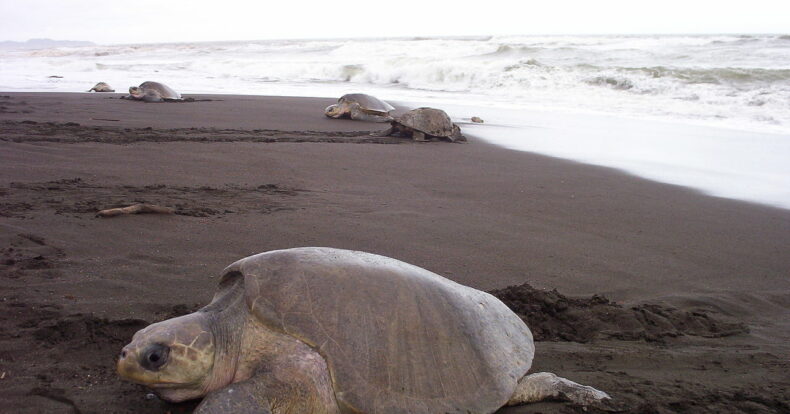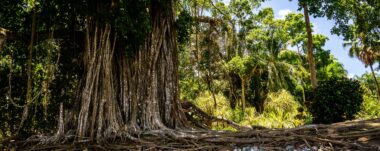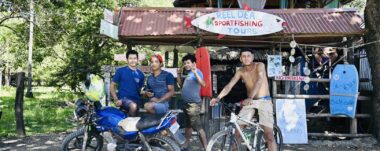Ostional, Costa Rica

Ostional is located on the Nicoya Peninsula, Guanacaste. This is one of the most important turtle nesting sites in Costa Rica. In the region, two towns are adjacent: the Wildlife Refuge and the town of Ostional.
The Refuge was created in 1984 with the purpose of protecting turtle nesting, especially the olive ridley turtle; it is also home to other animal species such as amphibians, mammals, birds and reptiles.
The turtles that lay their eggs on this beach are the hawksbill turtle, the green turtle, the leatherback turtle and the olive ridley turtle, the main host of this coast. Between 500,000 and 700,000 turtles can arrive here for their nesting period, either during the day or at night, which makes it a unique phenomenon in the world. According to data from the School of Biology of the UCR, in the year 2000 an estimated 1 million turtles arrived on the coast of Ostional.
These events began to occur in the late 1950s and were discovered and studied by University of Costa Rica biologist Douglas Robinson. Because of this, the Douglas Robinson Biological Station was founded to follow the arribada and nesting of olive ridley turtles.
Each of the turtles that arrive lay an average of 108 eggs per nest, which means that in an arrival of 500,000 turtles, the number of eggs laid would be 54 million. However, only 30% of these eggs survive.
What happens to the remaining 70%?
The turtles themselves, when they arrive to nest, destroy the eggs of other turtles that had arrived earlier; in addition, the heat in the dry season is not ideal for turtles to develop; also, animals such as dogs or carrion birds destroy the nests and eat the eggs that are there.
This is where the great work of the Ostional community comes in.
Hannia Rodríguez, from the University of Costa Rica, says that the Ostional community is an organized community. In fact, the Asociación de Desarrollo Integral de Ostional (ADIO) is in charge of collecting and distributing turtle eggs in a sustainable way. In this way, the eggs are consumed by a community that needs them and are not wasted, all while maintaining a high natural level in the area.
State institutions such as MINAE, SENASA and INCOPESCA, along with the School of Biology of the University of Costa Rica strictly supervise this activity.
Thanks to a five-year plan, the eggs are extracted. After the first turtles arrive on the beach, a declaration of arrival is made, which allows the extraction of eggs from 6:00 a.m. until 36 hours after the first arrival. Eggs can only be collected along the entire beach in the kilometers with the highest density of nests, since the next turtles to lay their eggs would destroy the previous ones.
Only members of the Asociación Nacidos en Ostional can remove the eggs, so almost all the families get together to help with this task. After the eggs have been extracted, they are packed in plastic bags (with sand, because this prevents diseases such as salmonella) of 200 units and are marketed in several regions of the country, such as San José.
The community of Ostional has subsisted from the turtle egg market for decades and thanks to this they have been able to build several community centers, the school’s computer center and the biological station of the region. On top of that, ADIO gives each inhabitant of Ostional 50 thousand colones for personal use, a kind of pension to adults over 70 years old and 100 turtle eggs to each family.
In terms of conservation, the community is dedicated to protecting the turtles (helping them to reach the sea or scaring away birds and dogs) and cleaning the beach, removing debris left by the sea on the coast. Without these actions, the number of turtles would be drastically reduced.
The ADIO project was born in 1987 as a solution to a problem that still exists in the area: the illegal plundering of turtle eggs. This project was fought for 8 years.
Ostional under threat
Despite the great conservation efforts, some environmentalists at the University of Costa Rica still have their doubts regarding the consumption of turtle eggs. Some believe that turtle eggs are very rich in protein and should therefore be left in the sand so that other animals can enjoy them, or that they should be washed out to sea and used there. Others claim that turtle eggs are harmful to humans because they contain high levels of cholesterol.
However, these rumors have been disproved since, according to studies, turtle eggs have 5% less cholesterol than chicken eggs and a higher concentration of protein. Likewise, it does not cause any harm for the community to take advantage of this product as a source of income and food, since only 1% of all turtle eggs are being extracted from the beach, leaving 92% intact.
Despite efforts to deny false information and rumors that egg extraction is illegal in Ostional, these facts, plus the murder of environmentalist Jairo Mora, gave way to various campaigns against the trade and consumption of turtle eggs.
Another serious problem in the area is trawling, carried out mainly by transnational companies, which considerably affects marine species, including turtles.
In addition, the families of Ostional are threatened with eviction. In fact, the Ostional Wildlife Refuge was created in 1983 and the entire infrastructure of the Ostional community was included in the territory of the refuge. For this reason, in 2009, the Court IV declared that the refuge is state-owned after several companies filed an injunction to evict the inhabitants of the refuge.
The families of Ostional then raised the TECOCOS law (Community Coastal Territories) in order to protect the beach from hotel companies that would affect more than 1000 inhabitants and the maritime territory of the area.
The inhabitants of Ostional continue their struggle and await a resolution to the problem.
SST Team in collaboration with Hannia Rodríguez, University of Costa Rica.
Previous article Ecology in Costa Rica - Escazú Agreements: Chile on the verge of rectifying, Costa Rica limiting itself with the others to... look?
Navigate articles





